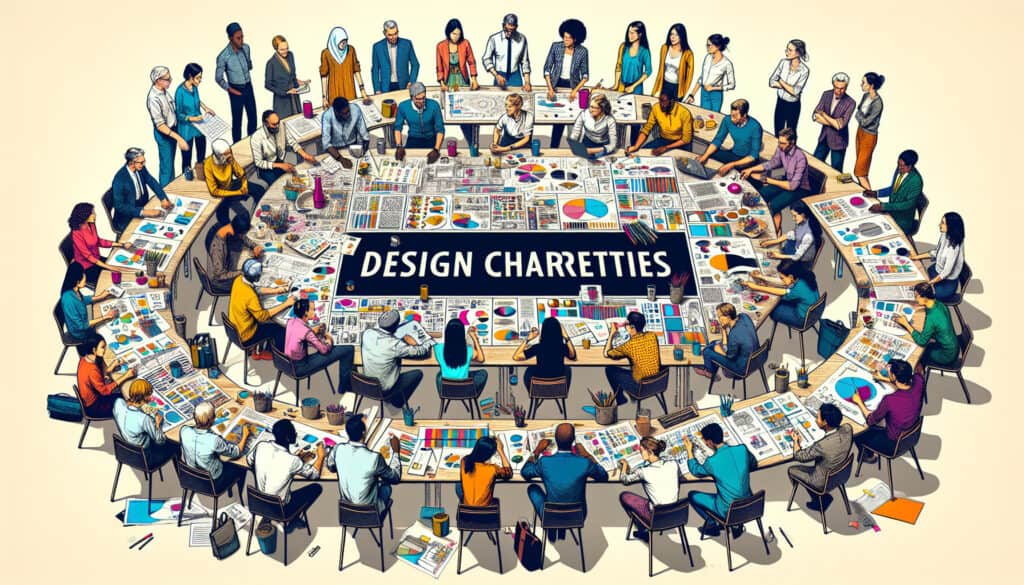An intense, collaborative design workshop where stakeholders (designers, clients, users, experts) come together to brainstorm and develop a solution to a 设计问题 in a concentrated period.
- 方法: 工程, 质量
设计研讨会

设计研讨会
- 敏捷方法论, 集思广益, 跨职能协作, 设计思维, Human-Centered Design, 迭代开发, 原型设计, 以使用者為中心的設計
目标
如何使用
- A charrette is a fast-paced, hands-on session where multiple ideas are proposed and sketched. The goal is to quickly generate and converge on a design direction through rapid collaboration.
优点
- Fosters collaboration and gets all stakeholders on the same page; generates a large number of ideas and a viable design solution very quickly; builds consensus and shared ownership.
缺点
- Can be exhausting and stressful due to the high intensity; requires a skilled facilitator to keep the session on track; the quality of the outcome depends on the quality of the participants.
类别
- 构思, 产品设计, 项目管理
最适合:
- Rapidly co-creating a solution to a design problem in a short, intensive, and collaborative workshop.
Design charrettes are frequently utilized in urban planning, architecture, and product development, bringing together diverse stakeholders such as designers, engineers, clients, and users throughout the different phases of a project, particularly during ideation and concept refinement. These intensive workshops often occur early in the design process, allowing rapid ideation and synthesis of varied perspectives that can enrich the final product. For example, in the context of urban redevelopment, a charrette may include local residents, planners, and environmental experts to collaboratively envision community spaces that meet ecological, social, and economic needs. This methodology provides a structured yet flexible format for brainstorming solutions, often utilizing sketching and visual tools to communicate ideas swiftly, which can lead to breakthrough innovations that might not arise in standard meetings. The participatory nature encourages engagement and can significantly reduce the time spent on revisions and misunderstandings later in the project by aligning different viewpoints early on. Organizations like the American Institute of Architects promote this approach for its ability to cultivate community involvement and garner a sense of shared investment in the outcomes, creating a platform where everyone can contribute, thus leading to a more 以用户为中心 design solution. Each session typically culminates in a tangible output or preliminary design direction that serves as a reference point for subsequent phases of development, reinforcing the commitment to collaboration and shared ownership among all participants, which is crucial for successful outcomes in interdisciplinary projects.
该方法的关键步骤
- Define the design problem clearly and ensure all participants understand it.
- Encourage idea generation through brainstorming and sketching sessions.
- Organize participants into small groups for focused discussions and ideation.
- Facilitate quick presentations of ideas from each group to share insights.
- Collect feedback on presented ideas from the entire group.
- Identify patterns and common themes among the ideas generated.
- Collaboratively refine and prioritize ideas for further development.
- Converge on a selected design direction that reflects collective input.
专业提示
- Incorporate rapid prototyping tools during the session to visualize concepts in real-time, enhancing understanding and engagement.
- Assign specific roles to participants, such as facilitator, scribe, and sketch artist, to optimize contributions and keep the session organized.
- Utilize divergent and convergent thinking techniques alternately, encouraging wild ideas before narrowing down to actionable solutions.
历史背景
1949
1950
1950
1960
1960
1960
1960
1940
1950
1950
1958
1960
1960
1960
1960
(如果日期不详或不相关,例如 "流体力学",则对其显著出现的时间作了四舍五入的估计)。















相关文章
蒙特卡罗模拟
基于模型的测试
型号检查
混合方法研究
防错(Poka-Yoke)
任务简介测试